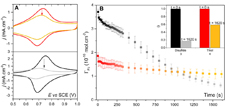Publication
841
Electrochim. Acta, 257,165-171, 2017
DOI:10.1016/j.electacta.2017.09.163
|
|
|
|
|
|

|
On the decisive role of the sulfur-based anchoring group in the electro-assisted formation of self-assembled monolayers on gold
|
|
|
|
Dany Capitao, Benoît Limoges, Claire Fave, and Bernd Schöllhorn
Laboratoire d’Electrochimie Moléculaire, UMR CNRS 7591, Université Paris Diderot, Sorbonne Paris Cité, 15 rue Jean-Antoine de Baïf, F-75205 Paris Cedex 13, France
A reproducible electro-assisted method is proposed to follow the influence of different sulfur-based anchoring groups on the adsorption kinetics and thermodynamics of SAM formation on gold electrodes. This has been made possible thanks to the preparation of several molecules containing various anchoring groups (thiol, thioester, acyclic and cyclic disulfides, thiosulfonate) while preserving the same spacer redox head group. In this paper we focus on the question of a substantial difference between SAMs derived from either alkylthiols or disulfides using cyclic voltammetry. The comparison of equilibrium surface coverage, affinity constant toward gold surface and stability suggest a decisive role of the nature of the anchoring group in the formation of the monolayers. Moreover, a significant difference of the desorption behavior of SAMs on gold, pre-formed from either thiol or disulfide, has clearly been demonstrated. |

